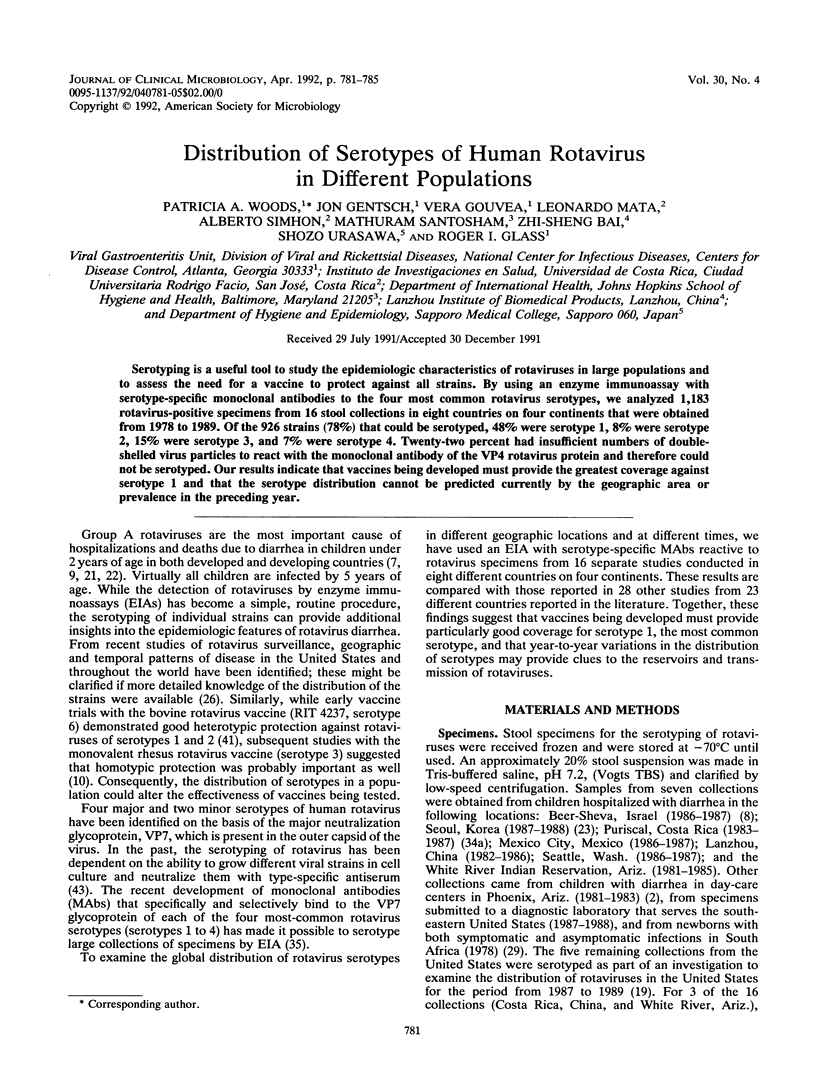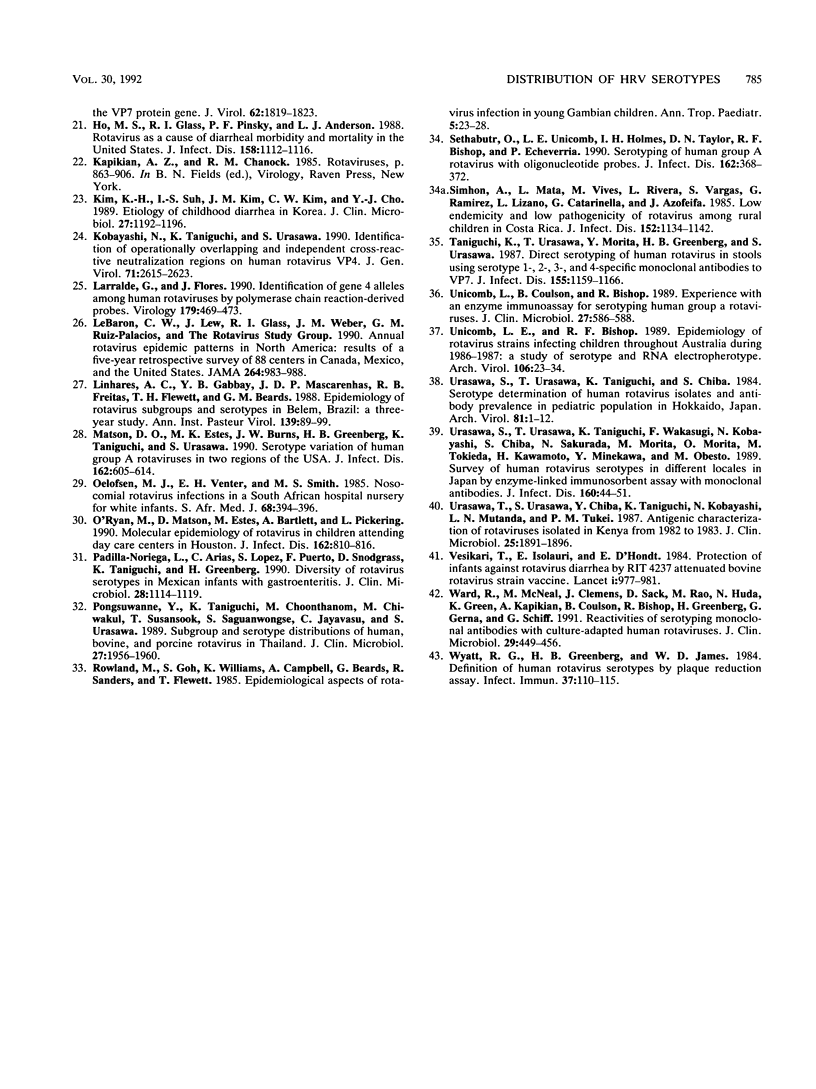Abstract
Serotyping is a useful tool to study the epidemiologic characteristics of rotaviruses in large populations and to assess the need for a vaccine to protect against all strains. By using an enzyme immunoassay with serotype-specific monoclonal antibodies to the four most common rotavirus serotypes, we analyzed 1,183 rotavirus-positive specimens from 16 stool collections in eight countries on four continents that were obtained from 1978 to 1989. Of the 926 strains (78%) that could be serotyped, 48% were serotype 1, 8% were serotype 2, 15% were serotype 3, and 7% were serotype 4. Twenty-two percent had insufficient numbers of double-shelled virus particles to react with the monoclonal antibody of the VP4 rotavirus protein and therefore could not be serotyped. Our results indicate that vaccines being developed must provide the greatest coverage against serotype 1 and that the serotype distribution cannot be predicted currently by the geographic area or prevalence in the preceding year.
Full text
PDF




Selected References
These references are in PubMed. This may not be the complete list of references from this article.
- Ahmed M. U., Taniguchi K., Kobayashi N., Urasawa T., Wakasugi F., Islam M., Shaikh H., Urasawa S. Characterization by enzyme-linked immunosorbent assay using subgroup- and serotype-specific monoclonal antibodies of human rotavirus obtained from diarrheic patients in Bangladesh. J Clin Microbiol. 1989 Jul;27(7):1678–1681. doi: 10.1128/jcm.27.7.1678-1681.1989. [DOI] [PMC free article] [PubMed] [Google Scholar]
- Bartlett A. V., Moore M., Gary G. W., Starko K. M., Erben J. J., Meredith B. A. Diarrheal illness among infants and toddlers in day care centers. I. Epidemiology and pathogens. J Pediatr. 1985 Oct;107(4):495–502. doi: 10.1016/s0022-3476(85)80004-4. [DOI] [PubMed] [Google Scholar]
- Beards G. M., Desselberger U., Flewett T. H. Temporal and geographical distributions of human rotavirus serotypes, 1983 to 1988. J Clin Microbiol. 1989 Dec;27(12):2827–2833. doi: 10.1128/jcm.27.12.2827-2833.1989. [DOI] [PMC free article] [PubMed] [Google Scholar]
- Bishop R. F., Unicomb L. E., Barnes G. L. Epidemiology of rotavirus serotypes in Melbourne, Australia, from 1973 to 1989. J Clin Microbiol. 1991 May;29(5):862–868. doi: 10.1128/jcm.29.5.862-868.1991. [DOI] [PMC free article] [PubMed] [Google Scholar]
- Bishop R. F., Unicomb L. E., Soenarto Y., Suwardji H., Ristanto, Barnes G. L. Rotavirus serotypes causing acute diarrhoea in hospitalized children in Yogyakarta, Indonesia during 1978-1979. Arch Virol. 1989;107(3-4):207–213. doi: 10.1007/BF01317917. [DOI] [PubMed] [Google Scholar]
- Brown D. W., Mathan M. M., Mathew M., Martin R., Beards G. M., Mathan V. I. Rotavirus epidemiology in Vellore, south India: group, subgroup, serotype, and electrophoretype. J Clin Microbiol. 1988 Nov;26(11):2410–2414. doi: 10.1128/jcm.26.11.2410-2414.1988. [DOI] [PMC free article] [PubMed] [Google Scholar]
- Cook S. M., Glass R. I., LeBaron C. W., Ho M. S. Global seasonality of rotavirus infections. Bull World Health Organ. 1990;68(2):171–177. [PMC free article] [PubMed] [Google Scholar]
- Dagan R., Bar-David Y., Sarov B., Katz M., Kassis I., Greenberg D., Glass R. I., Margolis C. Z., Sarov I. Rotavirus diarrhea in Jewish and Bedouin children in the Negev region of Israel: epidemiology, clinical aspects and possible role of malnutrition in severity of illness. Pediatr Infect Dis J. 1990 May;9(5):314–321. doi: 10.1097/00006454-199005000-00003. [DOI] [PubMed] [Google Scholar]
- Flores J., Sears J., Schael I. P., White L., Garcia D., Lanata C., Kapikian A. Z. Identification of human rotavirus serotype by hybridization to polymerase chain reaction-generated probes derived from a hyperdivergent region of the gene encoding outer capsid protein VP7. J Virol. 1990 Aug;64(8):4021–4024. doi: 10.1128/jvi.64.8.4021-4024.1990. [DOI] [PMC free article] [PubMed] [Google Scholar]
- Flores J., Taniguchi K., Green K., Perez-Schael I., Garcia D., Sears J., Urasawa S., Kapikian A. Z. Relative frequencies of rotavirus serotypes 1, 2, 3, and 4 in Venezuelan infants with gastroenteritis. J Clin Microbiol. 1988 Oct;26(10):2092–2095. doi: 10.1128/jcm.26.10.2092-2095.1988. [DOI] [PMC free article] [PubMed] [Google Scholar]
- Georges-Courbot M. C., Beraud A. M., Beards G. M., Campbell A. D., Gonzalez J. P., Georges A. J., Flewett T. H. Subgroups, serotypes, and electrophoretypes of rotavirus isolated from children in Bangui, Central African Republic. J Clin Microbiol. 1988 Apr;26(4):668–671. doi: 10.1128/jcm.26.4.668-671.1988. [DOI] [PMC free article] [PubMed] [Google Scholar]
- Gerna G., Arista S., Passarani N., Sarasini A., Battaglia M. Electropherotype heterogeneity within serotypes of human rotavirus strains circulating in Italy. Brief report. Arch Virol. 1987;95(1-2):129–135. doi: 10.1007/BF01311340. [DOI] [PubMed] [Google Scholar]
- Gerna G., Sarasini A., di Matteo A., Parea M., Orsolini P., Battaglia M. Identification of two subtypes of serotype 4 human rotavirus by using VP7-specific neutralizing monoclonal antibodies. J Clin Microbiol. 1988 Jul;26(7):1388–1392. doi: 10.1128/jcm.26.7.1388-1392.1988. [DOI] [PMC free article] [PubMed] [Google Scholar]
- Gorziglia M., Larralde G., Kapikian A. Z., Chanock R. M. Antigenic relationships among human rotaviruses as determined by outer capsid protein VP4. Proc Natl Acad Sci U S A. 1990 Sep;87(18):7155–7159. doi: 10.1073/pnas.87.18.7155. [DOI] [PMC free article] [PubMed] [Google Scholar]
- Gouvea V., Glass R. I., Woods P., Taniguchi K., Clark H. F., Forrester B., Fang Z. Y. Polymerase chain reaction amplification and typing of rotavirus nucleic acid from stool specimens. J Clin Microbiol. 1990 Feb;28(2):276–282. doi: 10.1128/jcm.28.2.276-282.1990. [DOI] [PMC free article] [PubMed] [Google Scholar]
- Gouvea V., Ho M. S., Glass R., Woods P., Forrester B., Robinson C., Ashley R., Riepenhoff-Talty M., Clark H. F., Taniguchi K. Serotypes and electropherotypes of human rotavirus in the USA: 1987-1989. J Infect Dis. 1990 Aug;162(2):362–367. doi: 10.1093/infdis/162.2.362. [DOI] [PubMed] [Google Scholar]
- Green K. Y., Sears J. F., Taniguchi K., Midthun K., Hoshino Y., Gorziglia M., Nishikawa K., Urasawa S., Kapikian A. Z., Chanock R. M. Prediction of human rotavirus serotype by nucleotide sequence analysis of the VP7 protein gene. J Virol. 1988 May;62(5):1819–1823. doi: 10.1128/jvi.62.5.1819-1823.1988. [DOI] [PMC free article] [PubMed] [Google Scholar]
- Gómez J., Estes M. K., Matson D. O., Bellinzoni R., Alvarez A., Grinstein S. Serotyping of human rotaviruses in Argentina by ELISA with monoclonal antibodies. Arch Virol. 1990;112(3-4):249–259. doi: 10.1007/BF01323169. [DOI] [PubMed] [Google Scholar]
- Ho M. S., Glass R. I., Pinsky P. F., Anderson L. J. Rotavirus as a cause of diarrheal morbidity and mortality in the United States. J Infect Dis. 1988 Nov;158(5):1112–1116. doi: 10.1093/infdis/158.5.1112. [DOI] [PubMed] [Google Scholar]
- Kim K. H., Suh I. S., Kim J. M., Kim C. W., Cho Y. J. Etiology of childhood diarrhea in Korea. J Clin Microbiol. 1989 Jun;27(6):1192–1196. doi: 10.1128/jcm.27.6.1192-1196.1989. [DOI] [PMC free article] [PubMed] [Google Scholar]
- Kobayashi N., Taniguchi K., Urasawa S. Identification of operationally overlapping and independent cross-reactive neutralization regions on human rotavirus VP4. J Gen Virol. 1990 Nov;71(Pt 11):2615–2623. doi: 10.1099/0022-1317-71-11-2615. [DOI] [PubMed] [Google Scholar]
- Larralde G., Flores J. Identification of gene 4 alleles among human rotaviruses by polymerase chain reaction-derived probes. Virology. 1990 Nov;179(1):469–473. doi: 10.1016/0042-6822(90)90317-k. [DOI] [PubMed] [Google Scholar]
- LeBaron C. W., Lew J., Glass R. I., Weber J. M., Ruiz-Palacios G. M. Annual rotavirus epidemic patterns in North America. Results of a 5-year retrospective survey of 88 centers in Canada, Mexico, and the United States. Rotavirus Study Group. JAMA. 1990 Aug 22;264(8):983–988. doi: 10.1001/jama.264.8.983. [DOI] [PubMed] [Google Scholar]
- Linhares A. C., Gabbay Y. B., Mascarenhas J. D., Freitas R. B., Flewett T. H., Beards G. M. Epidemiology of rotavirus subgroups and serotypes in Belem, Brazil: a three-year study. Ann Inst Pasteur Virol. 1988 Jan-Mar;139(1):89–99. doi: 10.1016/s0769-2617(88)80009-1. [DOI] [PubMed] [Google Scholar]
- Matson D. O., Estes M. K., Burns J. W., Greenberg H. B., Taniguchi K., Urasawa S. Serotype variation of human group A rotaviruses in two regions of the USA. J Infect Dis. 1990 Sep;162(3):605–614. doi: 10.1093/infdis/162.3.605. [DOI] [PubMed] [Google Scholar]
- O'Ryan M. L., Matson D. O., Estes M. K., Bartlett A. V., Pickering L. K. Molecular epidemiology of rotavirus in children attending day care centers in Houston. J Infect Dis. 1990 Oct;162(4):810–816. doi: 10.1093/infdis/162.4.810. [DOI] [PubMed] [Google Scholar]
- Oelofsen M. J., Venter E. H., Smith M. S. Nosocomial rotavirus infections in a South African hospital nursery for white infants. S Afr Med J. 1985 Sep 14;68(6):394–396. [PubMed] [Google Scholar]
- Padilla-Noriega L., Arias C. F., López S., Puerto F., Snodgrass D. R., Taniguchi K., Greenberg H. B. Diversity of rotavirus serotypes in Mexican infants with gastroenteritis. J Clin Microbiol. 1990 Jun;28(6):1114–1119. doi: 10.1128/jcm.28.6.1114-1119.1990. [DOI] [PMC free article] [PubMed] [Google Scholar]
- Pongsuwanne Y., Taniguchi K., Choonthanom M., Chiwakul M., Susansook T., Saguanwongse S., Jayavasu C., Urasawa S. Subgroup and serotype distributions of human, bovine, and porcine rotavirus in Thailand. J Clin Microbiol. 1989 Sep;27(9):1956–1960. doi: 10.1128/jcm.27.9.1956-1960.1989. [DOI] [PMC free article] [PubMed] [Google Scholar]
- Rowland M. G., Goh S. G., Williams K., Campbell A. D., Beards G. M., Sanders R. C., Flewett T. H. Epidemiological aspects of rotavirus infection in young Gambian children. Ann Trop Paediatr. 1985 Mar;5(1):23–28. doi: 10.1080/02724936.1985.11748354. [DOI] [PubMed] [Google Scholar]
- Sethabutr O., Unicomb L. E., Holmes I. H., Taylor D. N., Bishop R. F., Echeverria P. Serotyping of human group A rotavirus with oligonucleotide probes. J Infect Dis. 1990 Aug;162(2):368–372. doi: 10.1093/infdis/162.2.368. [DOI] [PubMed] [Google Scholar]
- Simhon A., Mata L., Vives M., Rivera L., Vargas S., Ramírez G., Lizano L., Catarinella G., Azofeifa J. Low endemicity and low pathogenicity of rotaviruses among rural children in Costa Rica. J Infect Dis. 1985 Dec;152(6):1134–1142. doi: 10.1093/infdis/152.6.1134. [DOI] [PubMed] [Google Scholar]
- Taniguchi K., Urasawa T., Morita Y., Greenberg H. B., Urasawa S. Direct serotyping of human rotavirus in stools by an enzyme-linked immunosorbent assay using serotype 1-, 2-, 3-, and 4-specific monoclonal antibodies to VP7. J Infect Dis. 1987 Jun;155(6):1159–1166. doi: 10.1093/infdis/155.6.1159. [DOI] [PubMed] [Google Scholar]
- Unicomb L. E., Bishop R. F. Epidemiology of rotavirus strains infecting children throughout Australia during 1986-1987. A study of serotype and RNA electropherotype. Arch Virol. 1989;106(1-2):23–34. doi: 10.1007/BF01311035. [DOI] [PubMed] [Google Scholar]
- Unicomb L. E., Coulson B. S., Bishop R. F. Experience with an enzyme immunoassay for serotyping human group A rotaviruses. J Clin Microbiol. 1989 Mar;27(3):586–588. doi: 10.1128/jcm.27.3.586-588.1989. [DOI] [PMC free article] [PubMed] [Google Scholar]
- Urasawa S., Urasawa T., Taniguchi K., Chiba S. Serotype determination of human rotavirus isolates and antibody prevalence in pediatric population in Hokkaido, Japan. Arch Virol. 1984;81(1-2):1–12. doi: 10.1007/BF01309292. [DOI] [PubMed] [Google Scholar]
- Urasawa S., Urasawa T., Taniguchi K., Wakasugi F., Kobayashi N., Chiba S., Sakurada N., Morita M., Morita O., Tokieda M. Survey of human rotavirus serotypes in different locales in Japan by enzyme-linked immunosorbent assay with monoclonal antibodies. J Infect Dis. 1989 Jul;160(1):44–51. doi: 10.1093/infdis/160.1.44. [DOI] [PubMed] [Google Scholar]
- Urasawa T., Urasawa S., Chiba Y., Taniguchi K., Kobayashi N., Mutanda L. N., Tukei P. M. Antigenic characterization of rotaviruses isolated in Kenya from 1982 to 1983. J Clin Microbiol. 1987 Oct;25(10):1891–1896. doi: 10.1128/jcm.25.10.1891-1896.1987. [DOI] [PMC free article] [PubMed] [Google Scholar]
- Vesikari T., Isolauri E., D'Hondt E., Delem A., André F. E., Zissis G. Protection of infants against rotavirus diarrhoea by RIT 4237 attenuated bovine rotavirus strain vaccine. Lancet. 1984 May 5;1(8384):977–981. doi: 10.1016/s0140-6736(84)92323-7. [DOI] [PubMed] [Google Scholar]
- Ward R. L., McNeal M. M., Clemens J. D., Sack D. A., Rao M., Huda N., Green K. Y., Kapikian A. Z., Coulson B. S., Bishop R. F. Reactivities of serotyping monoclonal antibodies with culture-adapted human rotaviruses. J Clin Microbiol. 1991 Mar;29(3):449–456. doi: 10.1128/jcm.29.3.449-456.1991. [DOI] [PMC free article] [PubMed] [Google Scholar]
- Wyatt R. G., Greenberg H. B., James W. D., Pittman A. L., Kalica A. R., Flores J., Chanock R. M., Kapikian A. Z. Definition of human rotavirus serotypes by plaque reduction assay. Infect Immun. 1982 Jul;37(1):110–115. doi: 10.1128/iai.37.1.110-115.1982. [DOI] [PMC free article] [PubMed] [Google Scholar]
- de Zoysa I., Feachem R. G. Interventions for the control of diarrhoeal diseases among young children: rotavirus and cholera immunization. Bull World Health Organ. 1985;63(3):569–583. [PMC free article] [PubMed] [Google Scholar]


